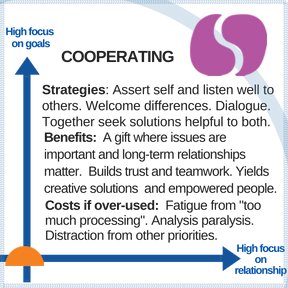 Try Using Cooperating More
Try Using Cooperating More 

You scored lower in this style in Calm settings than other styles. This suggests that in early stages of conflict, when it's just an everyday disagreement and things are not yet emotional, you use Cooperating less than other styles. This helps you avoid possible weaknesses of the Cooperating style, such as spending too much time and energy debating every small issue.
But Cooperating also has important strengths. If the gap between your Cooperating score in Calm and your highest score in another style in Calm is 3 points or more, you may be missing out on these strengths. Conflict is easier if you are good at all five styles, so you may get quick gains with more use of this style.
Strengths of Cooperating. Cooperating is a "both...and..." response to conflict. You both assert your own needs and support your opponent by thoughtfully hearing and supporting their needs. Cooperating requires investing time and energy into conversation to look at the needs of both sides and seek ways to address both.
Although it's not right for all circumstances, Cooperating is wise and necessary at times:
- When you care deeply about a conflicted issue in a relationship that matters to you.
- Where keeping both sides happy is important.
- When significant truth exists in the views of both sides.
- When you seek a creative new solution that requires careful study of all sides of the situation.
- When you want to develop skills of problem analysis and problem solving that may strengthen your capacity in other areas as well.
- When you want to create a sense of teamwork, high morale, and confidence in taking on difficult issues.
- When you want to break out of dynamics of competition and demonstrate ways of dealing with conflict that go beyond competition.
Improving Your Ability to Cooperate
Cooperating involves two sets of skills, asserting your own views and supporting your counterpart. Each set of skills requires some practice to learn in its own right. In the Cooperating conflict style you use them simultaneously. Because they have very differing qualities, these two skill sets may seem to be in tension with each other.
While you are still learning the skills, it helps to think of cooperating as taking turns. One side speaks while the other listens carefully. Then the other side speaks while the first listens.
Unless you were lucky enough to have good modeling of Cooperating by adults in your childhood, it may feel strange in the beginning. Expect to spend some time reading about and practicing this style to get good at it. A good place to start is with Lee Jay Berman's essay, "13 Tools for Resolving Conflict in the Workplace, with Customers and in Life". There are essays on this Riverhouse page (scroll to the section "Cooperating and Compromising as Conflict Styles") that offer many good ideas.
The styles you scored high in are valuable. Keep using them! But you may wish to experiment with getting more comfortable with Cooperating, especially in settings where you really care about both the relationship and the issues involved.



 Need assistance? Email center@riverhouseepress.com with a copy of the login instructions you received and a brief description of what is happening. We'll reply in one business day-usually less.
Need assistance? Email center@riverhouseepress.com with a copy of the login instructions you received and a brief description of what is happening. We'll reply in one business day-usually less. 